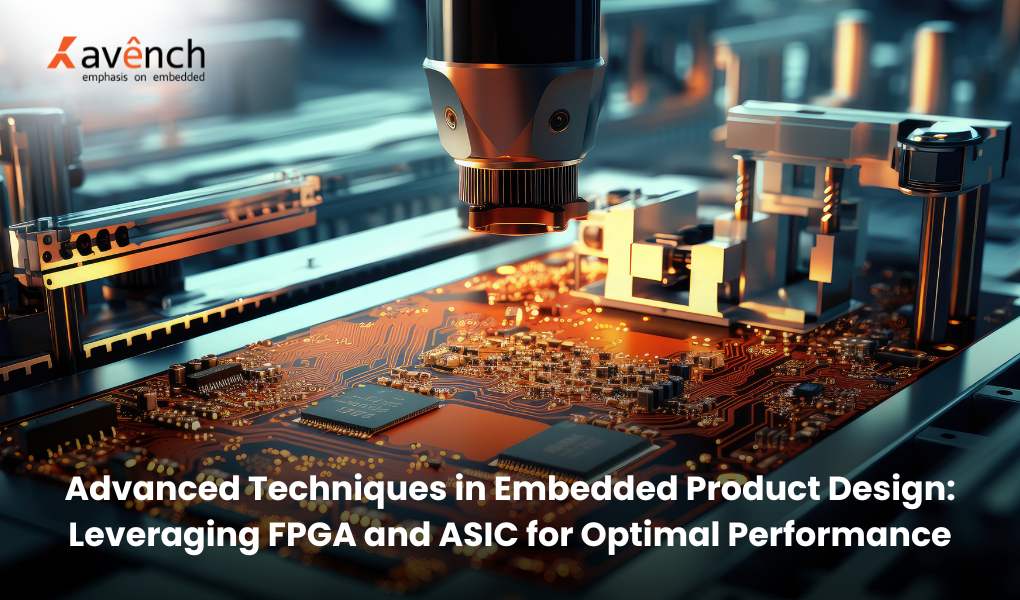In the arena of embedded product design, selection and usage of the right hardware technologies can often achieve optimum performance. The two biggest elements likely to affect performance the most are field-programmable gate arrays( FPGAs) and application-specific integrated circuits (ASICs). This blog explains some advanced techniques for using FPGAs and ASICs under the embedded product design to enhance performance, reliability, and efficiency.
FPGA in Embedded Product Design
FPGAs offer unparalleled flexibility in embedded product design. These devices allow for post-manufacture reconfiguration, making them an excellent choice for prototyping and applications where updates and modifications are anticipated. FPGAs provide a platform where logic can be customized to specific needs, facilitating high-speed data processing and parallelism that general-purpose processors often struggle to achieve.
 Key Advantages of FPGAs
Key Advantages of FPGAs
- Reconfigurability: One of the most significant advantages of FPGAs in embedded product design and development is their ability to be reprogrammed. This feature is particularly valuable during the prototyping phase, where changes are frequent.
- Parallel Processing: FPGAs have an added advantage in applications that may call for parallelism. Works can, therefore, be partitioned and handled by several logic blocks to improve performance on computationally intensive applications.
- Low Latency: An FPGA solution will have lower latency compared to a general-purpose processor-based solution, as it has dedicated hardware logic.
FPGA Design Process
The design process for embedded systems involving FPGAs typically includes several key steps:
- Requirement Analysis: Define the specific requirement of the application, such as performance and power consumption, besides the interfacing needs.
- System Architecture Design: Define a top-level architecture fulfilling the development’s requirements. This involves the selection of appropriate models for the FPGA, in addition to determining the necessary peripheral components.
- Hardware Description Language (HDL) Coding: Writing HDL code, usually located in VHDL or Verilog, to specify the operation and architecture of the FPGA.
- Simulation and Verification: Simulate the HDL code to test its correctness and performance versus recorded requirements.
- Synthesis and Implementation: Synthesize the HDL code and through mapping it to the FPGA architecture and technology schematic convert it into a bitstream for download to the FPGA.
- Testing and Debugging: Will test and debug the design strongly by loading the bitstream in the FPGA to ensure that the enhancements are satisfied by the given application needs.
ASIC in Embedded Product Design
ASICs, on the other hand, are custom-designed for specific applications. Unlike FPGAs, ASICs are not reprogrammable after fabrication, which makes them less flexible but highly optimized for performance and power efficiency. ASICs are ideal for high-volume production where the design requirements are well-defined and unlikely to change.
 Key Advantages of ASICs
Key Advantages of ASICs
- Performance Optimization: Since ASICs are designed for the implementation of particular tasks, they can be optimized and hence have better performance with lower power dissipation than that of generic solutions.
- Size and Power Efficiency: Custom design will enable the ASIC to be smaller and more power-efficient—two things important to portable and battery-operated devices.
- Cost Efficiency at Scale: Because economies of scale come into play with high volume production, for large quantities, this makes ASICs more cost-effective than FPGAs.
ASIC Design Process
The steps involved in the design process of an embedded system for ASICs are more complicated and time-consuming compared to FPGAs, but they ensure that the final product will be very much optimized.
- Specification of Requirements: Detailed specifications for functionality, performance, and power-rate requirements are developed.
- Architectural Design: This defines the overall architecture by stating how this ASIC is going to interface with other components of the system.
- Logic Design: The RTL, or Register-Transfer Level design, will be developed using HDL. This should confirm that it will meet the specifications required.
- Verification: The correctness of the design is checked through proper simulation and formal verification before moving to physical design.
- Physical Design: A ready-for-fabrication physical layout is generated from the RTL design that has been validated. This hence includes floor planning, placement, and routing.
- Fabrication and Testing: The ASIC is processed for fabrication in a semiconductor foundry followed by rigorous testing to prove its performance and functionality.
FPGA vs. ASIC: Choosing Between Them
Choosing between FPGA and ASIC for embedded product design depends on several factors:
- Flexibility vs. Optimizations: FPGAs provide flexibility due to reconfigurability and hence are useful for prototyping, while many applications may need updates; ASICs offer better optimizations in terms of performance and power efficiency but not flexibility.
- Development Time and Cost: FPGA designs can be developed and iterated quickly, while ASIC development is time-consuming and very expensive. This makes the latter moreover recommended for products of a high volume, where an initial investment is high, but compensated by the lower cost per unit.
- Performance Requirements: If an application needs the highest performance with power efficiency, then ASIC is the choice. On the other hand, for applications requiring flexibility and faster time-to-market, FPGAs are found to be more suitable.
Embedded Product Design Services
The embedded product design companies hence play a major role in harnessing FPGAs and ASICs effectively. Companies specializing in embedded product design services will offer experience in FPGA and ASIC design methodologies to guarantee the very best solution possible for any particular application. For instance, any embedded product design company in Bangalore or embedded product design companies in the USA can execute a design completely from concept to production with their deep knowledge and experience in the products.
Conclusion
In advanced embedded product design, leveraging FPGAs and ASICs appropriately can lead to significant performance improvements and cost efficiencies. Only FPGAs provide ultimate flexibility, due to which they are a perfect match for prototyping and those applications where updates are frequently required. Optimization of the highest order in performance makes ASICs suitable for high-volume production where efficiency is paramount. The strengths of both and their limitations can help make the correct decisions within the embedded system design process to come up with successful and efficient embedded products.
Avench is one of the leading embedded product design companies in usa. For any sales queries, contact us at +1 (775) 404-5757. You can also email us at sales@avench.com. We will be happy to assist you.

 Key Advantages of FPGAs
Key Advantages of FPGAs Key Advantages of ASICs
Key Advantages of ASICs